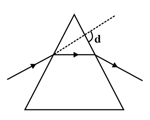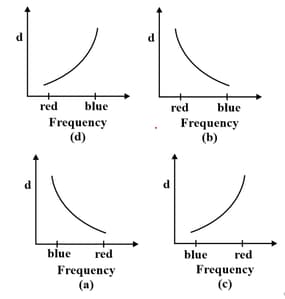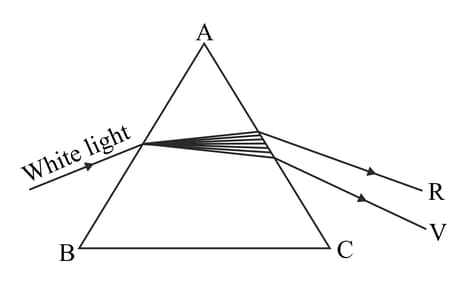HARD
10th CBSE
IMPORTANT
Earn 100
A prism ABC with (BC as base) is placed in different orientations. A narrow beam of white light is incident on the prism as shown in the figure. In which of the following cases, after dispersion, the third colour from the top corresponds to the colour of the sky.


(a)(i)
(b)(ii)
(c)(iii)
(d)(iv)
50% studentsanswered this correctly

Important Questions on The Human Eye and the Colourful World
HARD
10th CBSE
IMPORTANT
Light rays are deviated by a prism as given below:

The deviation angle is measured for light rays of different frequency including blue light and red light. Which graph is correct?

MEDIUM
10th CBSE
IMPORTANT
Two identical prisms and are given. White light is passed through as shown below: Which of the following positions of will again yield white light:

MEDIUM
10th CBSE
IMPORTANT
A glass prism can be used to show the dispersion of white light to form a spectrum. Draw a diagram to show how a ray of white light is dispersed as it passes through a prism.
MEDIUM
10th CBSE
IMPORTANT
While performing the experiment to trace the path of a ray of light passing through glass prism, four students marked the incident ray and the emergent ray in their diagrams in the manner shown below:

The correct path of the rays has been shown by:
MEDIUM
10th CBSE
IMPORTANT
When a ray passes through a prism:
MEDIUM
10th CBSE
IMPORTANT
Is it necessary for the cross-section of a prism to be any specific type of triangle like an equilateral triangle?
HARD
10th CBSE
IMPORTANT
Match the items in Column I to those in Column II
| Column I | Column II |
| (a) Dispersion | (p) caused due to atmospheric refraction by different layers of air of varying refractive indices |
| (b) Angle of deviation | (q) the phenomenon causing advance sunrise and delayed sunset |
| (c) Atmospheric refraction | (r) refraction of light occurring in atmosphere |
| (d) Scattering of light | (s) angle between the emergent ray and the normal in a prism |
| (e) Twinkling of stars | (t) makes clear sky blue in colour |
| (u) makes sunrise and sunset reddish | |
| (v) none |
MEDIUM
10th CBSE
IMPORTANT
Two identical prisms and are given. Which of their following placement will yield maximum dispersion:
